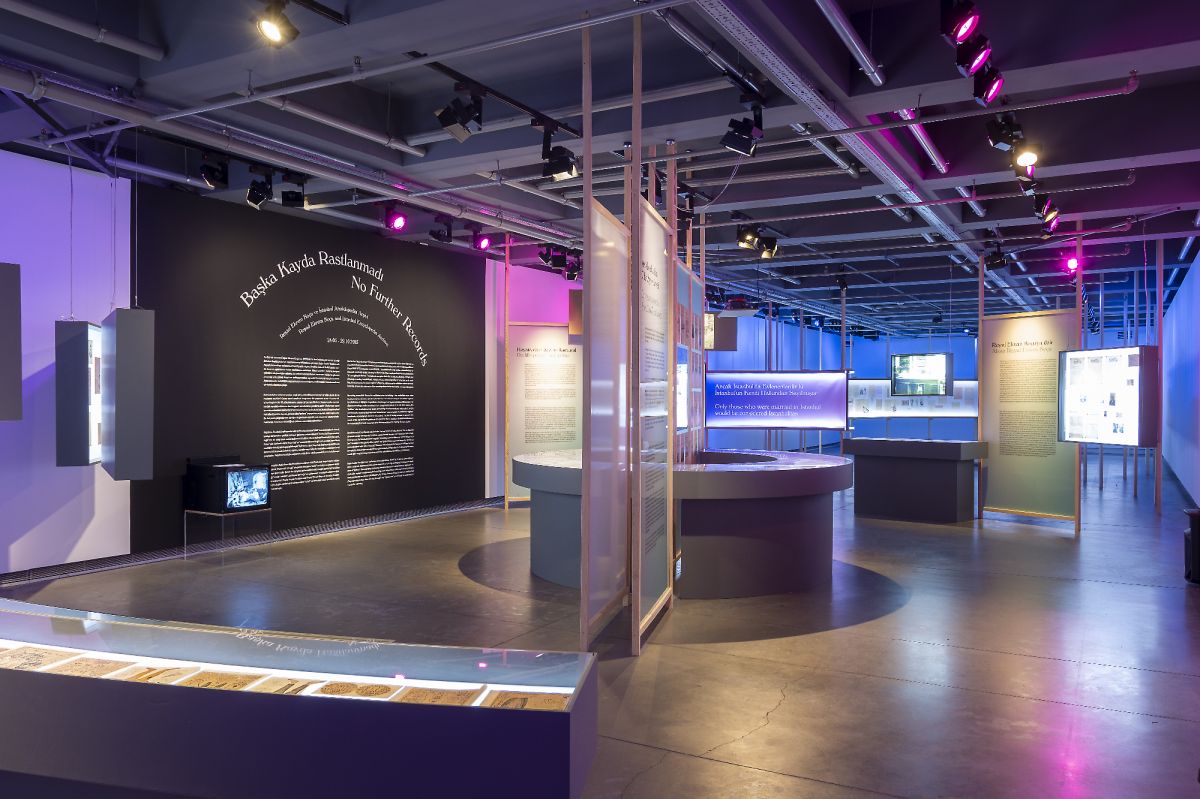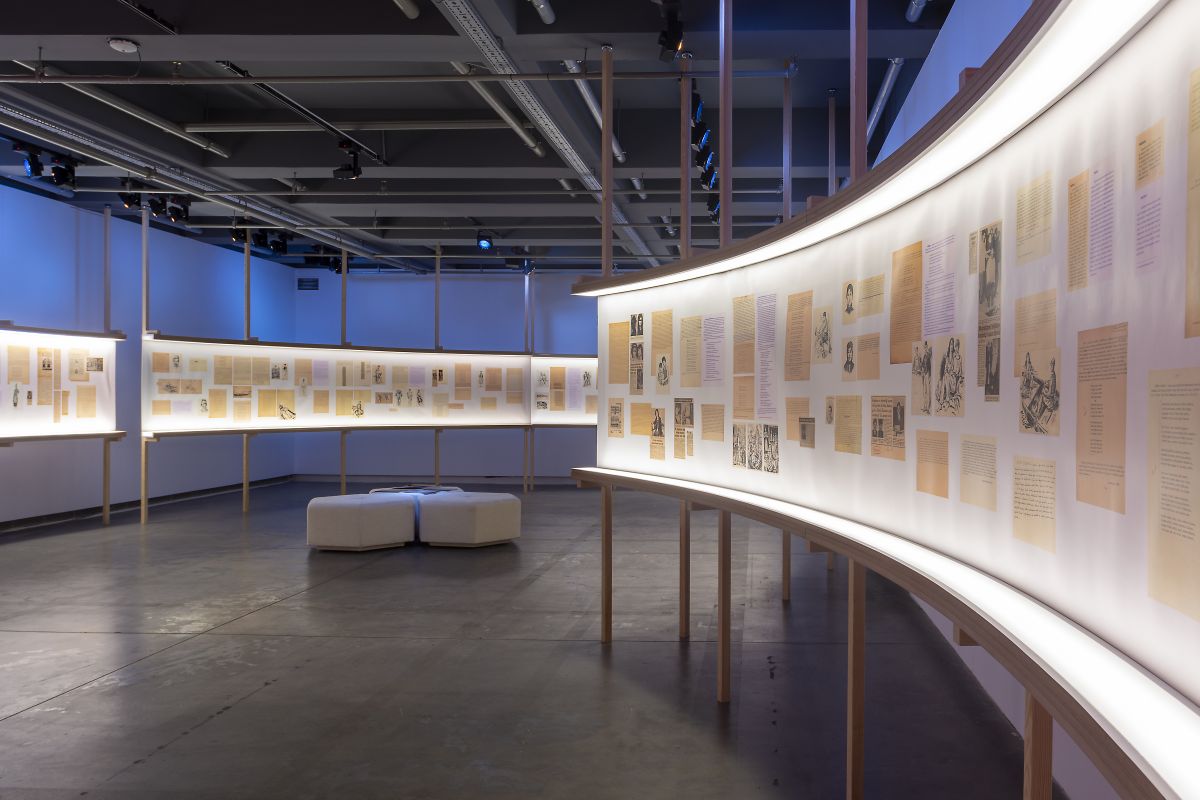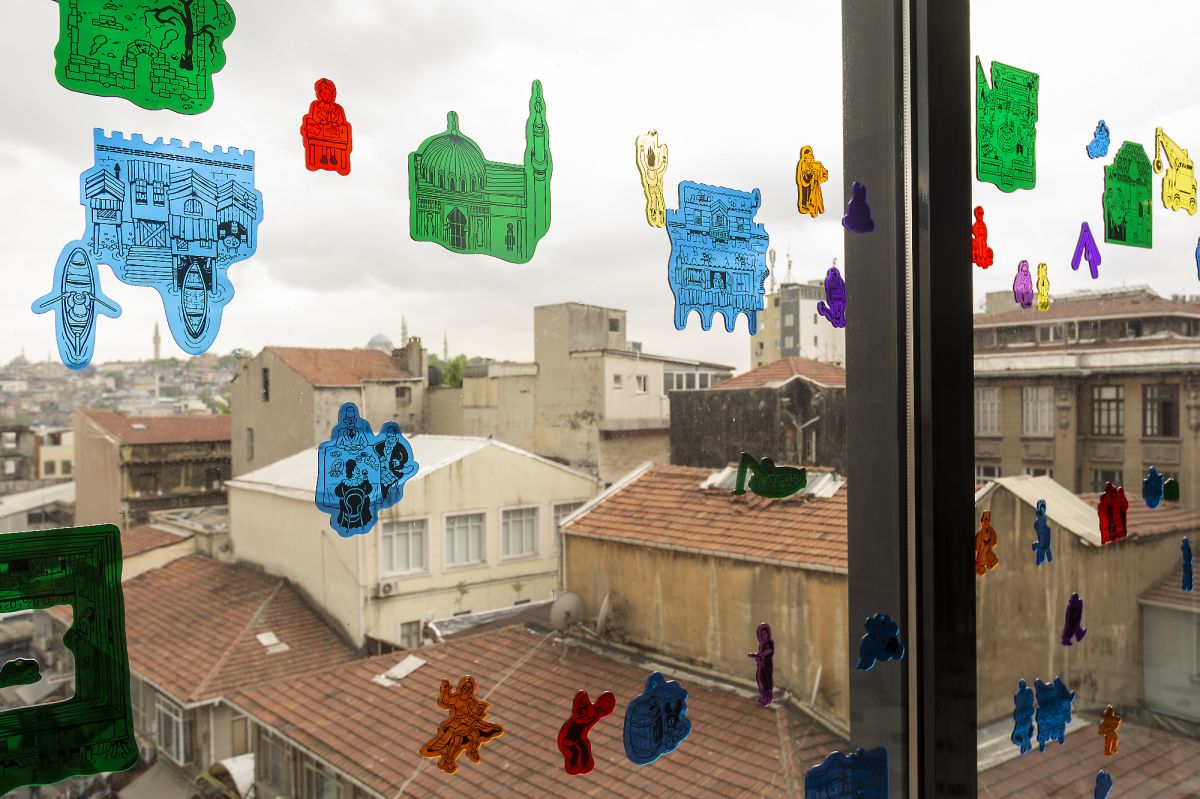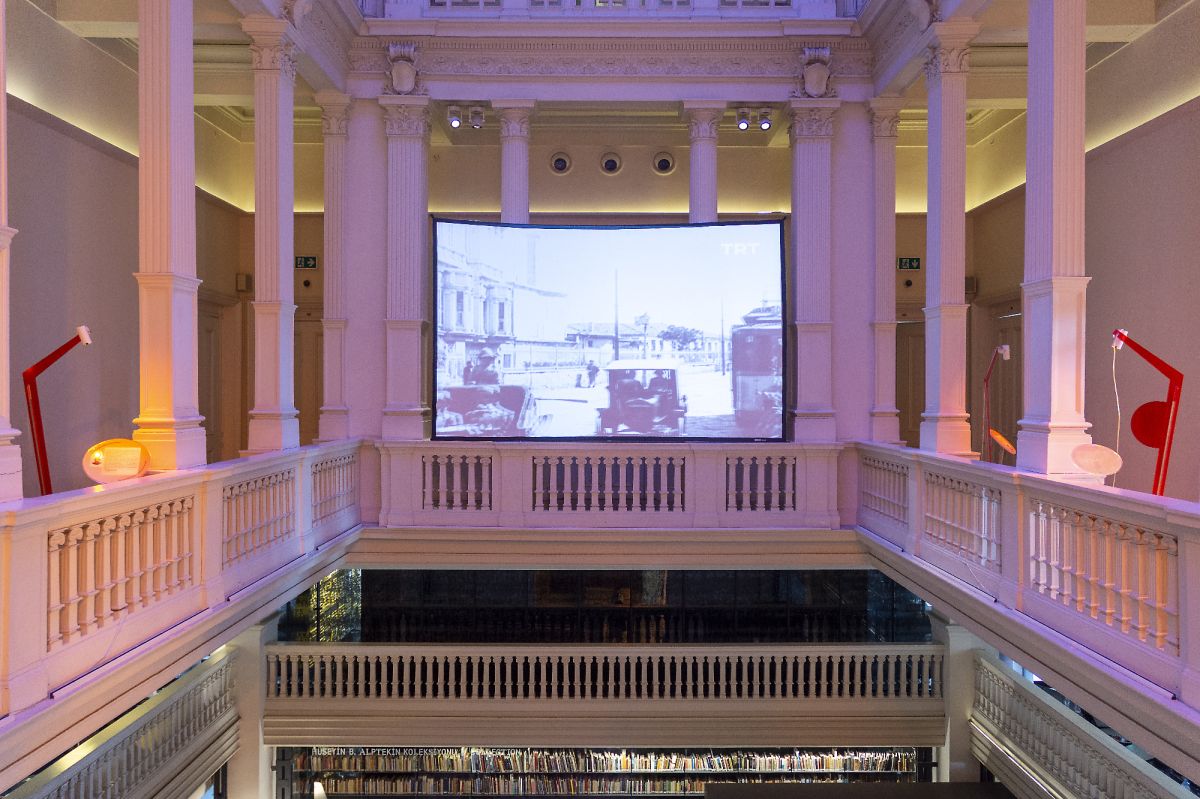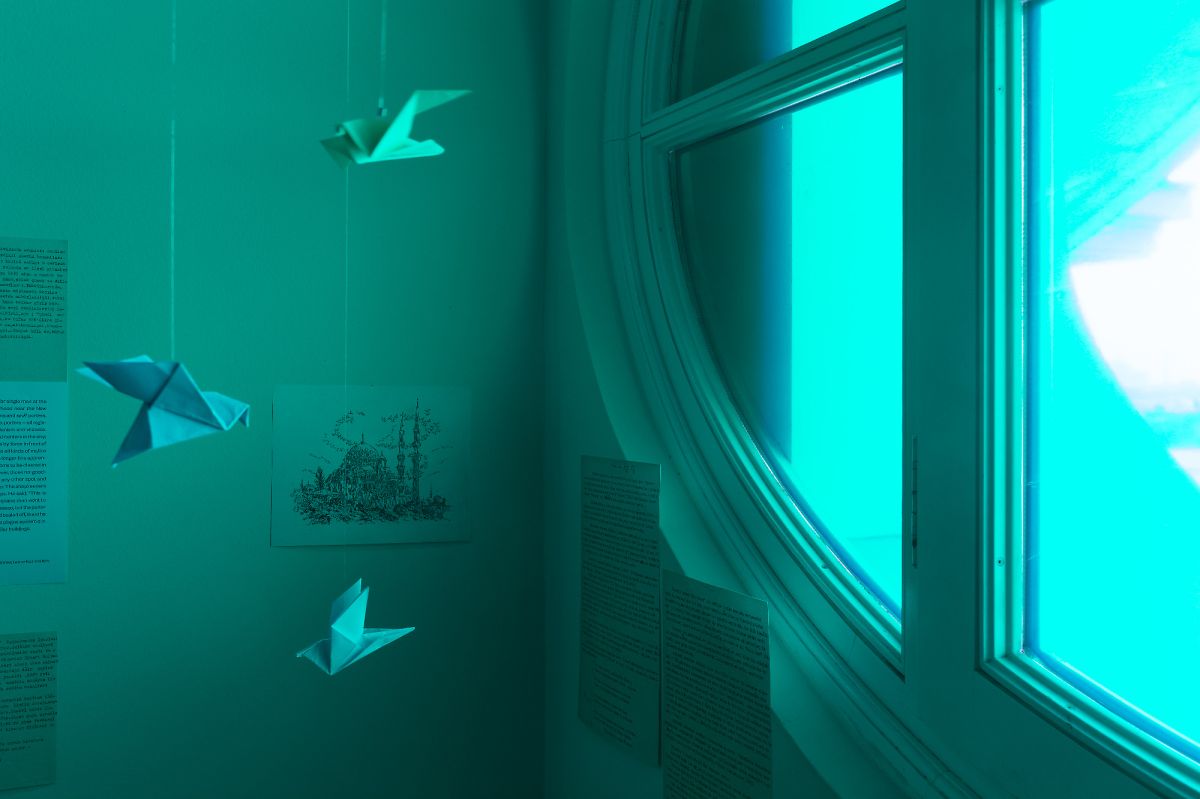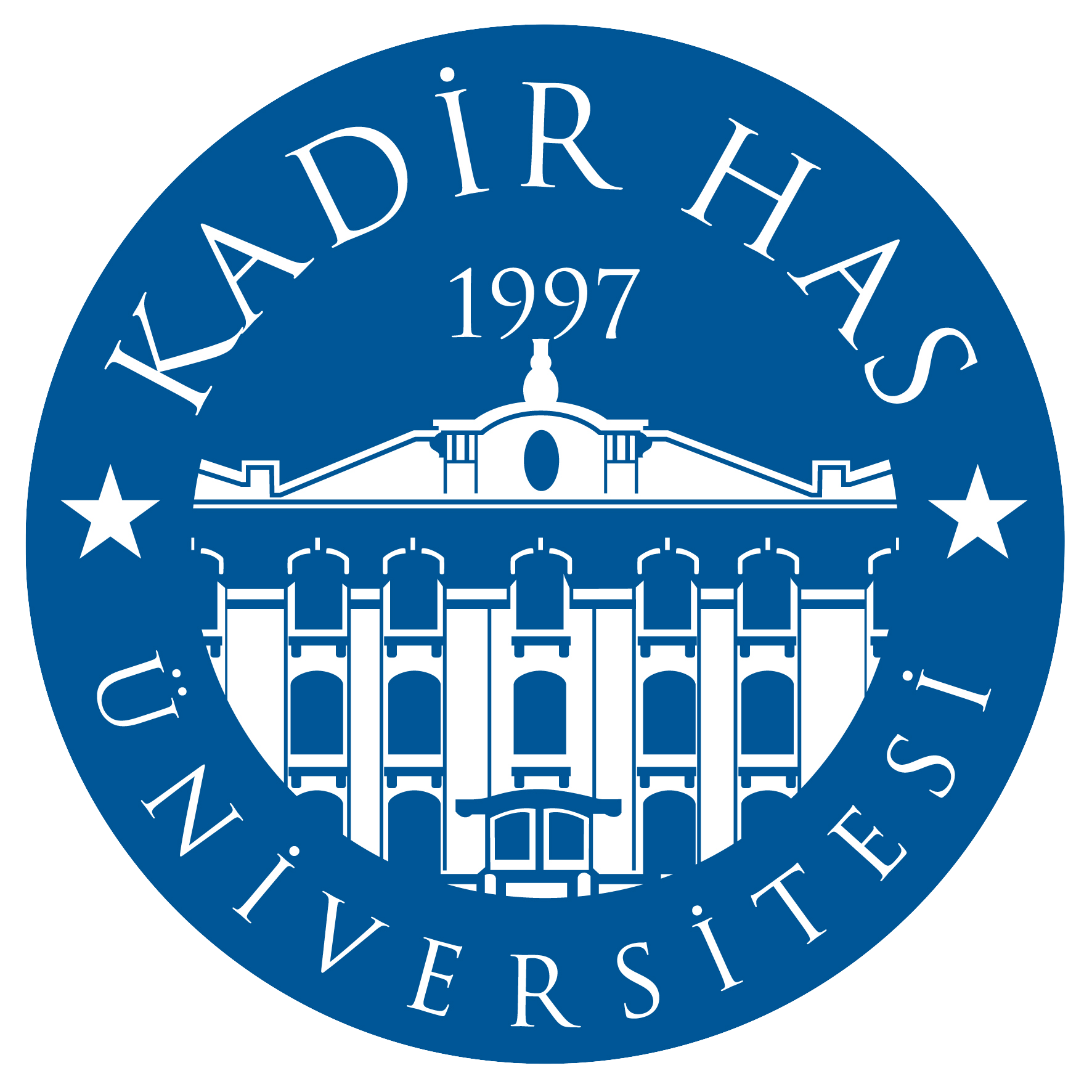Exhibition
No Further Records: Reşad Ekrem Koçu and Istanbul Encyclopedia Archive
Salt Galata
May 24 – October 29, 2023
Organized as part of Reşad Ekrem Koçu and Istanbul Encyclopedia Archive, a joint project of Salt and Kadir Has University initiated in 2018, the exhibition No Further Records: Reşad Ekrem Koçu and Istanbul Encyclopedia Archive sheds light on the unpublished sections of the Istanbul Encyclopedia to which historian and novelist Reşad Ekrem Koçu (1905-1975) devoted most of his life.
The exhibition focuses on the articles that had remained in the design stage, following the 11 volumes of the encyclopedia printed until the letter “G” during Koçu’s lifetime. The materials comprise drafts for the articles, clippings, collages, and drawings, revealing the privileged position of Koçu in historiography as he had set out to manifest, in his own words, the “grand register” of Istanbul. At the same time, the exhibition seeks to comprehend the idiosyncratic elements of the encyclopedia and what makes this work a grand register.
Spreading across Salt Galata, the exhibition takes the building’s location as an urban focal point and presents a selection of materials in a framework shaped around the neighborhood of Galata. It highlights the particular urban image that Koçu created about Galata, its immediate surroundings, and its inhabitants from the early 19th century to the mid-20th century. The “lowlives” who lived in the urban space surrounding the aforementioned building for a century and those who lived in a relatively more “unrestrained” manner outside the traditional neighborhood order of Istanbul are traced in the archive. This line of inquiry pursues the uncanny elements of the city under the guidance of Koçu rather than a repetition of narratives situated on the home-neighborhood-monument axis, which constitutes the majority of urban studies.
Koçu’s Istanbul Encyclopedia also includes “serious” topics of urban history. Yet, the historian does not bring a new approach to these topics; instead, he uses such issues to create a legitimate ground for Istanbul’s “grand register.” According to the art historian Semavi Eyice, Koçu had “sidestepped the gravity of the matter” and “glossed over important issues that need to be treated in detail with only a few lines.” However, this attitude is the foundation of Koçu’s unique perspective. Urban history studies focusing on streets, buildings, objects, or demographic movements gain components previously unrecorded within the framework Koçu constructed.
In particular, the statement “no further records have been found” at the end of some of the articles on certain characters points to how the claim to form a “grand register” exposes the weakness of “serious” historiography. Koçu often uses the expression vesile-i rahmet [a graceful occasion] to explain the reasoning for including urban inhabitants in the record, which posits his work outside the narrative of official history. No Further Records: Reşad Ekrem Koçu and Istanbul Encyclopedia Archive looks into the “strange” and “impertinent” city of those not on record, for a graceful occasion.
In parallel with the exhibition, the printed volumes of the Istanbul Encyclopedia and a collection of approximately 40,000 items have been digitized and will soon be accessible online. Offering a different perspective on 19th and 20th century Istanbul, the exhibition and the archive will be accompanied by an e-publication with contributions of researchers from diverse fields. Public programs accompanying the exhibition will be announced via saltonline.org and Salt’s social media channels.
About Reşad Ekrem Koçu
Reşad Ekrem Koçu was born in Istanbul in 1905. He graduated from the Bursa High School in 1921 and the Istanbul University Faculty of Literature History Department in 1931. He was the student and assistant of Ahmed Refik Altınay, and when Altınay was removed from his position in 1933, as the university reform went into effect, Koçu resigned from the newly established university. He taught history at the Kuleli Military High School, Vefa High School, and Pertevniyal High School. In addition to his experience as a history teacher, he made a living by contributing articles to newspapers such as Cumhuriyet, Yeni Sabah, Milliyet, Hergün, Yeni Tanin, and Tercüman and magazines including Hayat Tarih Mecmuası, Resimli Tarih Mecmuası, Tarih Dünyası, Hayat, Yeşilay, Büyük Doğu, Hafta, Türk Folklor Araştırmaları and İstanbul Enstitüsü Mecmuası. He published historical novels and novelized monographs on historical characters. In November 1944, he began publishing the fascicles of the Istanbul Encyclopedia, which he defined as the “grand register of the city,” focusing on historical, geographic, architectural, literary, folkloric, and cultural topics. He said of the encyclopedia: “As of now, I will squander my life on it,” and continued working on it until the end of his life. After 34 fascicles were published intermittently, he had to take a break in 1951 due to financial reasons. The encyclopedia was relaunched beginning with the first fascicle in 1958, and this adventure lasted 173 fascicles and 11 volumes. Ending on the article Gökçınar (Mehmed), the fascicle dated 1973 marked the end of the Istanbul Encyclopedia’s publishing life. Koçu passed away two years later, on July 6, 1975, and was buried in the Sahrayıcedid Cemetery. The historian lost the mansion he inherited from his father, his money, and his health to form Istanbul’s “grand register.” The location of his grave could never be determined.
* * *
Program: Bülent Tanju, Cansu Yapıcı, Gülce Özkara, Masum Yıldız
Design and Production: Emirhan Altuner
Project Team: Ahmet Metin Öztürk, Gül İçel, Mehtap Kuru, Mustafa Hazneci, Sinem Ayşe Gülmez Saydam
Illustration:Cem Dinlenmiş
Editor: Erman Ata Uncu, Ezgi Yurteri
Translation: Merve Ünsal
Installation: Eray Özcan, Fiksatif, 3T Reklam
Research and Digitization: Ayşe Buluş, Ayşe Tuğba Silahtar, Büşra İyibaş, Derya Dertli, Dilay Dik, Elif Başgöl, Emre Ayvaz, Esra Nalbant, Gelengül Erkara, Lorans Tanatar Baruh, Murat Tülek, Özge Ertem, Sinan Çetin, Yağmur Torun, Yonca Güneş Yücel
Kadir Has University: Aybike Batuk, Ezgi Tuncer, Gürbey Hiz, Mehmet Manyas, Serap Özyurt
Acknowledgments: Ada Tuncer, Ahmet Ersoy, Ali Cindoruk, Aslıhan Demirtaş, Aslıhan Şenel, Asya Ece Uzmay, Atıl Aggündüz, Cemal Kafadar, Cemre Yeşil Gönenli, Channel Studio, CLEVER°FRANKE, Çiğdem Kafesçioğlu, Eda Çağıl Çağlarırmak, Edhem Eldem, Elif Birdoğan, Emine Gönel, Enis Batur, Erdem Yücel, Esra Kahveci, Firuzan Melike Sümertaş, Genç Açı Proje Ofisi (GAPO), Gene Kogan, Hasan Deniz, Irvin Cemil Schick, Lalin Akalın, Mehmet Kentel, Nurtaç Buluç, Oğul Öztunç, Orhan Pamuk, Osman Bozkurt, Özlem Hemiş, Sait Ali Köknar, Selim S. Kuru, Sermet Tolan, Shirine Hamadeh, Sinem Serap Duran, Suraiya Faroqhi, Süleyman Şenel, Tan Morgül, Uğur Aktaş, Uğur Tanyeli, Vasıf Kortun
The archive and research project, conducted by Salt together with Kadir Has University on the Istanbul Encyclopedia, was initiated in 2018 by Meriç Öner, Former Director of Salt Research and Programs, and architect-academic Arzu Erdem.
The exhibition is realized with the support of Mey|Diageo (opening reception), STABILO (workshop space), and Yıldız Entegre (production). Eureko Sigorta (insurance) and Jotun Boya (paint) provide service support to Salt throughout the year.
In Collaboration with
The exhibition focuses on the articles that had remained in the design stage, following the 11 volumes of the encyclopedia printed until the letter “G” during Koçu’s lifetime. The materials comprise drafts for the articles, clippings, collages, and drawings, revealing the privileged position of Koçu in historiography as he had set out to manifest, in his own words, the “grand register” of Istanbul. At the same time, the exhibition seeks to comprehend the idiosyncratic elements of the encyclopedia and what makes this work a grand register.
Spreading across Salt Galata, the exhibition takes the building’s location as an urban focal point and presents a selection of materials in a framework shaped around the neighborhood of Galata. It highlights the particular urban image that Koçu created about Galata, its immediate surroundings, and its inhabitants from the early 19th century to the mid-20th century. The “lowlives” who lived in the urban space surrounding the aforementioned building for a century and those who lived in a relatively more “unrestrained” manner outside the traditional neighborhood order of Istanbul are traced in the archive. This line of inquiry pursues the uncanny elements of the city under the guidance of Koçu rather than a repetition of narratives situated on the home-neighborhood-monument axis, which constitutes the majority of urban studies.
Koçu’s Istanbul Encyclopedia also includes “serious” topics of urban history. Yet, the historian does not bring a new approach to these topics; instead, he uses such issues to create a legitimate ground for Istanbul’s “grand register.” According to the art historian Semavi Eyice, Koçu had “sidestepped the gravity of the matter” and “glossed over important issues that need to be treated in detail with only a few lines.” However, this attitude is the foundation of Koçu’s unique perspective. Urban history studies focusing on streets, buildings, objects, or demographic movements gain components previously unrecorded within the framework Koçu constructed.
In particular, the statement “no further records have been found” at the end of some of the articles on certain characters points to how the claim to form a “grand register” exposes the weakness of “serious” historiography. Koçu often uses the expression vesile-i rahmet [a graceful occasion] to explain the reasoning for including urban inhabitants in the record, which posits his work outside the narrative of official history. No Further Records: Reşad Ekrem Koçu and Istanbul Encyclopedia Archive looks into the “strange” and “impertinent” city of those not on record, for a graceful occasion.
In parallel with the exhibition, the printed volumes of the Istanbul Encyclopedia and a collection of approximately 40,000 items have been digitized and will soon be accessible online. Offering a different perspective on 19th and 20th century Istanbul, the exhibition and the archive will be accompanied by an e-publication with contributions of researchers from diverse fields. Public programs accompanying the exhibition will be announced via saltonline.org and Salt’s social media channels.
About Reşad Ekrem Koçu
Reşad Ekrem Koçu was born in Istanbul in 1905. He graduated from the Bursa High School in 1921 and the Istanbul University Faculty of Literature History Department in 1931. He was the student and assistant of Ahmed Refik Altınay, and when Altınay was removed from his position in 1933, as the university reform went into effect, Koçu resigned from the newly established university. He taught history at the Kuleli Military High School, Vefa High School, and Pertevniyal High School. In addition to his experience as a history teacher, he made a living by contributing articles to newspapers such as Cumhuriyet, Yeni Sabah, Milliyet, Hergün, Yeni Tanin, and Tercüman and magazines including Hayat Tarih Mecmuası, Resimli Tarih Mecmuası, Tarih Dünyası, Hayat, Yeşilay, Büyük Doğu, Hafta, Türk Folklor Araştırmaları and İstanbul Enstitüsü Mecmuası. He published historical novels and novelized monographs on historical characters. In November 1944, he began publishing the fascicles of the Istanbul Encyclopedia, which he defined as the “grand register of the city,” focusing on historical, geographic, architectural, literary, folkloric, and cultural topics. He said of the encyclopedia: “As of now, I will squander my life on it,” and continued working on it until the end of his life. After 34 fascicles were published intermittently, he had to take a break in 1951 due to financial reasons. The encyclopedia was relaunched beginning with the first fascicle in 1958, and this adventure lasted 173 fascicles and 11 volumes. Ending on the article Gökçınar (Mehmed), the fascicle dated 1973 marked the end of the Istanbul Encyclopedia’s publishing life. Koçu passed away two years later, on July 6, 1975, and was buried in the Sahrayıcedid Cemetery. The historian lost the mansion he inherited from his father, his money, and his health to form Istanbul’s “grand register.” The location of his grave could never be determined.
Program: Bülent Tanju, Cansu Yapıcı, Gülce Özkara, Masum Yıldız
Design and Production: Emirhan Altuner
Project Team: Ahmet Metin Öztürk, Gül İçel, Mehtap Kuru, Mustafa Hazneci, Sinem Ayşe Gülmez Saydam
Illustration:Cem Dinlenmiş
Editor: Erman Ata Uncu, Ezgi Yurteri
Translation: Merve Ünsal
Installation: Eray Özcan, Fiksatif, 3T Reklam
Research and Digitization: Ayşe Buluş, Ayşe Tuğba Silahtar, Büşra İyibaş, Derya Dertli, Dilay Dik, Elif Başgöl, Emre Ayvaz, Esra Nalbant, Gelengül Erkara, Lorans Tanatar Baruh, Murat Tülek, Özge Ertem, Sinan Çetin, Yağmur Torun, Yonca Güneş Yücel
Kadir Has University: Aybike Batuk, Ezgi Tuncer, Gürbey Hiz, Mehmet Manyas, Serap Özyurt
Acknowledgments: Ada Tuncer, Ahmet Ersoy, Ali Cindoruk, Aslıhan Demirtaş, Aslıhan Şenel, Asya Ece Uzmay, Atıl Aggündüz, Cemal Kafadar, Cemre Yeşil Gönenli, Channel Studio, CLEVER°FRANKE, Çiğdem Kafesçioğlu, Eda Çağıl Çağlarırmak, Edhem Eldem, Elif Birdoğan, Emine Gönel, Enis Batur, Erdem Yücel, Esra Kahveci, Firuzan Melike Sümertaş, Genç Açı Proje Ofisi (GAPO), Gene Kogan, Hasan Deniz, Irvin Cemil Schick, Lalin Akalın, Mehmet Kentel, Nurtaç Buluç, Oğul Öztunç, Orhan Pamuk, Osman Bozkurt, Özlem Hemiş, Sait Ali Köknar, Selim S. Kuru, Sermet Tolan, Shirine Hamadeh, Sinem Serap Duran, Suraiya Faroqhi, Süleyman Şenel, Tan Morgül, Uğur Aktaş, Uğur Tanyeli, Vasıf Kortun
The archive and research project, conducted by Salt together with Kadir Has University on the Istanbul Encyclopedia, was initiated in 2018 by Meriç Öner, Former Director of Salt Research and Programs, and architect-academic Arzu Erdem.
The exhibition is realized with the support of Mey|Diageo (opening reception), STABILO (workshop space), and Yıldız Entegre (production). Eureko Sigorta (insurance) and Jotun Boya (paint) provide service support to Salt throughout the year.
In Collaboration with
